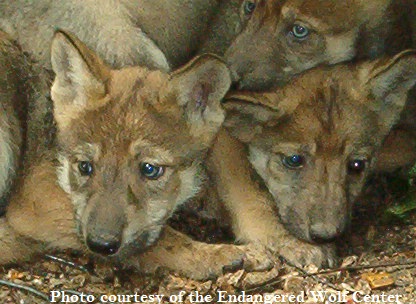22
Jun
In the News: Captive-born Mexican wolf pups doing well

ALBUQUERQUE, NM — Eight young Mexican wolf pups are now being cared for and raised by surrogate wild wolf parents after a successful attempt to introduce them into existing wolf litters in Arizona and New Mexico. The young wolves were placed in their foster dens by scientists from the Mexican Wolf Species Survival Plan group and Interagency Field Team (IFT), as a way to restore the rare gray wolf subspecies to its former range.
In a technique known as cross-fostering, four Mexican wolf pups were placed into wild dens in late April; two into a pack in Arizona and two into a pack in New Mexico. Last month, four more captive-born pups were cross-fostered into two wild dens; both in New Mexico. All of the pups were born at the Endangered Wolf Center in Eureka, Missouri, and fostered out at two weeks old or less.
Cross-fostering is a proven way to introduce pups into the litter of an experienced wild female to improve genetic diversity of the wild population.
“We are adaptively managing Mexican wolves in order to produce a population that is not measured by numbers alone, but by genetic robustness, desirable wild behavior and survivability,” said Amy Lueders, the U.S. Fish and Wildlife Service’s Southwest Regional Director. “Cross-fostering is just one of the management tools we use to improve the genetic health of the wild population.”
“The Arizona Game and Fish Department, U.S. Fish and Wildlife Service and our dedicated partners have been at the forefront of Mexican wolf conservation for 20 years,” said Jim deVos, assistant director of wildlife management for AZGFD. “The use of cross-fostering is proving to be a very success method to introduce new genetics into the wild population, which is key to recovery. While much work still must be done for this endangered subspecies, providing eight genetically important pups to the wild is huge progress toward genetic management and eventually recovery.”
“Now that we’ve placed the pups in the den, we will continue to remotely monitor the packs through GPS locations and radio telemetry signals to avoid further disturbance,” said John Oakleaf, Field Projects Coordinator for the Service. “Later, through remote camera observations and efforts to trap the young of the year, we hope to document the survival of the cross-fostered pups.”
Partners in the effort to recover Mexican wolves include the Service and its partners in Mexico, the Arizona Game and Fish Department, White Mountain Apache Tribe, U.S. Forest Service, USDA’s Animal and Plant Health Inspection Service —Wildlife Services, participating counties and the members of the Mexican Wolf Species Survival Plan.
This article was published in the White Mountain Independent
~~~~~~~
Show your support for Mexican wolves with a Letter to the Editor today!
The letters to the editor page is one of the most widely read, influential parts of the newspaper. One letter from you can reach thousands of people and will also likely be read by decision-makers. Tips for writing your letter are below, but please write in your own words, from your own experience. Don’t try to include all the talking points in your letter.
Letter Writing Tips & Talking Points
- Cross-fostering wolves is only one tool in the U.S. Fish and Wildlife Service’s toolbox and cannot be relied upon solely to save the Mexican gray wolf from extinction. Releases of captive adult wolves are desperately needed this year to save the species.
- The genetic crisis Mexican gray wolves are in is expected to result in lower pup survival rates, which we are now seeing. The only way to prevent the species from going extinct is to rapidly improve the genetics of the wild population by releasing adult wolves from captivity. Without releasing adults, the wild population could crash very quickly due to its small size and inbreeding.
- The U.S. Fish and Wildlife Service will not see the 10% annual population growth of Mexican gray wolves they claim they want to achieve with the methods they are employing. Their plan to recover the species without ever releasing an adult wolf to the wild again is preposterous and in bad faith.
- The U.S. Fish and Wildlife Service must get serious about curbing illegal killings of endangered Mexican gray wolves by increasing public acceptance of wolves, increasing penalties to dissuade wolf killers, and by accepting contemporary research on negative impacts of removing wolves who depredate.
- It has now been 40 years since the U.S. Fish and Wildlife Service first listed the Mexican gray wolf under the Endangered Species Act, yet the species is still struggling to remain viable.
- We have a moral, economic and scientific responsibility to restore endangered species like the Mexican gray wolf.
Make sure you:
“¢ Thank the paper for publishing the article
“¢ Submit your letter as soon as possible. The chance of your letter being published declines after a day or two since the article was published
“¢ Do not repeat any negative messages from the article, such as “so and so said that wolves kill too many cows, but”¦” Remember that those reading your letter will not be looking at the article it responds to, so this is an opportunity to get out positive messages about wolf recovery rather than to argue with the original article
“¢ Keep your letter brief, under 450 words
“¢ Include something about who you are and why you care: E.g. “I am a mother, outdoors person, teacher, business owner, scientific, religious, etc.”
“¢ Provide your name, address, phone number, and address. The paper won’t publish these, but they want to know you are who you say you are.
Submit your letter to the editor of the White Mountain Independent



